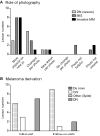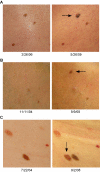Comparative analysis of total body and dermatoscopic photographic monitoring of nevi in similar patient populations at risk for cutaneous melanoma
- PMID: 20653722
- PMCID: PMC3025478
- DOI: 10.1111/j.1524-4725.2010.01589.x
Comparative analysis of total body and dermatoscopic photographic monitoring of nevi in similar patient populations at risk for cutaneous melanoma
Abstract
Background: Our previous experience monitoring nevi in high-risk patients using serial digital epiluminescence microscopy (DELM) photography achieved low biopsy rates but was limited by melanomas presenting as new lesions or arising from nevi that had not been photographed.
Objective: To determine whether biopsy rates, efficiency of melanoma detection, and melanoma origin (de novo vs nevus derived) differed in a similar patient population monitored using total body (TB) photography.
Methods: One thousand seventy-six patients (including 187 from a prior cohort) underwent TB photography and were monitored using photographs obtained at the initial visit. Risk factors and median monitoring periods for these patients were comparable with those of patients previously monitored using DELM photography.
Results: Two hundred seventy-five biopsies were performed in 467 patients on follow-up visits. Of 12 melanomas detected on follow-up, five were invasive, five presented as changing lesions and two as new lesions, nine arose de novo, and the remainder were nevus derived.
Conclusions: In our experience with both approaches, monitoring patients at risk for melanoma using TB photography was associated with lower biopsy rates and lower nevus-to-melanoma ratios than using DELM and facilitated detection of new and changing lesions. In both cohorts, the majority of melanomas detected on follow-up arose de novo.
Figures



Comment in
-
Total body photography versus digital dermoscopic follow-up in the diagnosis of pigmented lesions.Dermatol Surg. 2011 Mar;37(3):406-7. doi: 10.1111/j.1524-4725.2011.01901.x. Dermatol Surg. 2011. PMID: 21410826 No abstract available.
Similar articles
-
Incidence of new and changed nevi and melanomas detected using baseline images and dermoscopy in patients at high risk for melanoma.Arch Dermatol. 2005 Aug;141(8):998-1006. doi: 10.1001/archderm.141.8.998. Arch Dermatol. 2005. PMID: 16103329
-
Characterization of 1152 lesions excised over 10 years using total-body photography and digital dermatoscopy in the surveillance of patients at high risk for melanoma.J Am Acad Dermatol. 2012 Nov;67(5):836-45. doi: 10.1016/j.jaad.2012.01.028. Epub 2012 Apr 20. J Am Acad Dermatol. 2012. PMID: 22521205
-
The impact of total body photography on biopsy rate in patients from a pigmented lesion clinic.J Am Acad Dermatol. 2007 Sep;57(3):428-34. doi: 10.1016/j.jaad.2007.02.036. Epub 2007 Jul 10. J Am Acad Dermatol. 2007. PMID: 17624623
-
Role of In Vivo Reflectance Confocal Microscopy in the Analysis of Melanocytic Lesions.Acta Dermatovenerol Croat. 2018 Apr;26(1):64-67. Acta Dermatovenerol Croat. 2018. PMID: 29782304 Review.
-
Non-invasive tools for the diagnosis of cutaneous melanoma.Skin Res Technol. 2017 Aug;23(3):261-271. doi: 10.1111/srt.12350. Epub 2016 Nov 22. Skin Res Technol. 2017. PMID: 27878858 Review.
Cited by
-
Discriminating Nevi from Melanomas: Clues and Pitfalls.Dermatol Clin. 2016 Oct;34(4):395-409. doi: 10.1016/j.det.2016.05.003. Dermatol Clin. 2016. PMID: 27692446 Free PMC article. Review.
-
Skin self-examinations and visual identification of atypical nevi: comparing individual and crowdsourcing approaches.Cancer Epidemiol. 2013 Dec;37(6):979-84. doi: 10.1016/j.canep.2013.09.004. Epub 2013 Sep 26. Cancer Epidemiol. 2013. PMID: 24075797 Free PMC article.
-
[Monitoring a melanocytic tumor. When is excision indicated?].Hautarzt. 2011 Oct;62(10):774-7. doi: 10.1007/s00105-011-2218-6. Hautarzt. 2011. PMID: 21892645 German.
-
Sequential digital dermatoscopic imaging of patients with multiple atypical nevi.Dermatol Pract Concept. 2018 Jul 31;8(3):231-237. doi: 10.5826/dpc.0803a16. eCollection 2018 Jul. Dermatol Pract Concept. 2018. PMID: 30116670 Free PMC article.
-
Standard Dermatoscope Images vs an Autonomous Total Body Photography and Dermoscopic Imaging Device.JAMA Dermatol. 2025 Jun 1;161(6):615-621. doi: 10.1001/jamadermatol.2025.0565. JAMA Dermatol. 2025. PMID: 40202727
References
-
- Tucker MA, et al. Risk of melanoma and other cancers in melanoma-prone families. J Invest Dermatol. 1993;100:350S–55S. - PubMed
-
- Kelly JW, et al. A high incidence of melanoma found in patients with multiple dysplastic naevi by photographic surveillance. Med J Aust. 1997;167:191–94. - PubMed
-
- Lucas CR, et al. Early melanoma detection: nonuniform dermoscopic features and growth. J Am Acad Dermatol. 2003;48:663–71. - PubMed
Publication types
MeSH terms
Grants and funding
LinkOut - more resources
Full Text Sources
Other Literature Sources
Medical

